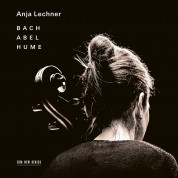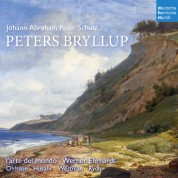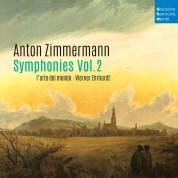Classics Explained: Beethoven - Symphony No. 6, 'Pastoral' - CD
Tükendi
Bu Ürün Stoklarımıza Girince Haberdar Olmak İster Misiniz?
(+) Stoklara Girince Haber Ver
(+) Stoklara Girince Haber Ver
Ürün Hakkında
Barkod: 0636943803424
, Katalog No: 8.558034-35 , Firma: Naxos
, Seri: Naxos Classics Explained
, Yayınlanma Tarihi:
5 Temmuz 2002
Format Türü: CD, Format: 2 CD
Eser Listesi
- CD - 1
- Symphony No. 6 in F Major, Op. 68, "Pastoral": I. Awakening of Cheerful Feelings on Arriving in the Country (1808)
- 1. On Beethoven's Openings
- 00:01:26

- 2. Opening phrase of the 'Pastoral': ood, Symbolism and Musical Function
- 00:01:44

- 3. Musical Acorns: the outline of melody; the shape of a question
- 00:00:42

- 4. The 'question' in the 'Pastoral' repeated...
- 00:00:04

- 5. ...and answered
- 00:00:12

- 6. The opening phrase ends on a note full of pregnant expectation
- 00:00:19

- 7. Starting with a stop
- 00:00:36

- 8. The rhythmic profile of the opening phrase; a two-part construction
- 00:00:52

- 9. Phrase One, Part One
- 00:00:09

- 10. Phrase One, Part Two
- 00:00:06

- 11. The properties of rhythmic ambiguity; the 'question' of Phrase One answered
- 00:01:03

- 12. Phrase Two: from meander to march
- 00:00:27

- 13. The makings of a conversation: contrast and variation
- 00:00:47

- 14. Repetition as A Major factor, but it's never mere repetition; each time something new is added
- 00:00:33

- 15. From soft to loud and back again; instrumental enrichment from horns and double-basses
- 00:00:18

- 16. Mega-repetition: violins play exactly the same little fragment ten times in a row
- 00:00:29

- 17. But no two repetitions are quite the same; varieties of contrast
- 00:00:34

- 18. More variation: pitch rises; violins joined frist by the clarinet, then by the oboe
- 00:00:19

- 19. Return to opening idea, but with new instrumentation and articulation
- 00:00:25

- 20. Clarinets, horns, bassoons and flutes now join expansive variation
- 00:00:49

- 21. 'New' insistent rhythm derived from the first four notes of the piece
- 00:00:09

- 22. With the dawn chorus, a whole forest is waking up; feelings of rapture
- 00:00:36

- 23. First violins play a derivative of the opening figure, joined by wind and strings
- 00:00:32

- 24. Sudden change of key, from the home key (tonic) to the dominant
- 00:00:30

- 25. Arrival at the hightly contrasting second main theme
- 00:00:55

- 26. Unusual properties of second main theme
- 00:02:15

- 27. Rhythmic clash between simultaneous groups of three beats and groups of two
- 00:01:09

- 28. winds fall selent as the violins and violas interrupt with a new theme
- 00:00:30

- 29. Winds answer with the same morse-like rhythm but at half the speed
- 00:00:51

- 30. Crescendo leads to strings' acceleration of the pace with no increase in tempo
- 00:01:05

- 31. Beginning of coda, directly based on morse-like rhythm of the main theme
- 00:00:22

- 32. Strings reiterate small fragment of the new theme 13 times in a row
- 00:00:48

- 33. A simple, rising violin phrase leads to a repeat of the Exposition
- 00:00:18

- 34. The nature and function of the Development section in sonata form; 'harmonic' rhythm explained
- 00:02:22

- 35. The nature of harmonic rhythm illustrated
- 00:00:35

- 36. A typically Beethovenian exercise in the frustration of expectation
- 00:00:38

- 37. Repetitiousness and magic effected largely through instrumental colour
- 00:00:42

- 38. Then come four, almost identical bars
- 00:00:08

- 39. Even greater magic, with sudden switch of key and tone colour
- 00:00:28

- 40. Entire Development section up to this point
- 00:01:55

- 41. The Development continued
- 00:01:23

- 42. Increased unease and suspense as harmonic rhythm accelerates
- 00:02:03

- 43. Arrival at the point of Recapitulation; back to the beginning, as a reminder
- 00:01:50

- 44. Beginning of Recapitulation
- 00:00:50

- 45. More Beethovenian frustrations of expectations which he himself has just set up
- 00:01:01

- 46. Harmonic rhythm speeds up, giving the impression of an accent on every beat
- 00:00:34

- 47. Prevailing mood restored; new theme from clarinets and bassoons
- 00:00:28

- 48. Violins and violas take up theme; horns, cellos, double-basses accompany
- 00:00:48

- 49. A hush falls, followed by a return of the movement's most familiar tag in strings
- 00:00:58

- 50. Clarinet takes up the running triplet figures of the main closing theme
- 00:00:32

- 51. First violins take up the opening phrase again, accompanied by double-basses
- 00:00:37

- 52. Beethoven slips in one last surprise; cue to complete movement
- 00:00:59

- 53. First movement (complete)
- 00:11:01

- Second Movement: Scene by the Brook
- 54. General introduction; the birth of a melody
- 00:01:59

- 55. Brook music quickens; syncopated horns; theme changes hands; evocation of birdsong
- 00:01:19

- 56. The 'motto' theme introduced by violins and treated to round-like overlappings
- 00:00:52

- 57. Transitional 'bridge' theme sets off for new key group. But is it? And does it?
- 00:00:39

- 58. Will he, or won't he? Beethoven keeps us guessing
- 00:01:09

- 59. The run-up to the Second Group
- 00:01:14

- 60. Arrival at the Second Group; but where is the actual Second Subject?
- 00:00:39

- 61. A new tune is introduced by the bassoon
- 00:00:38

- 62. Tune is repeated three times
- 00:01:00

- 63. ...which the full orchestra now takes up in varied form
- 00:00:45

- 64. Theme carried by flutes and first violins in a charmingly waltz-like development
- 00:00:48

- 65. A reminder of precedent
- 00:00:14

- 66. Back to the prevailing triple-metre with violins, bassoons and flutes
- 00:00:16

- 67. Another reminder of precedent...
- 00:00:16

- 68. ...and a cue to some unexpected departures
- 00:00:38

- 69. The transformational magic of Beethoven's 'tone-painting' - and a new varation
- 00:00:50

- 70. Conversation of clarinet, flute and oboe on the way to the Development
- 00:00:43

- 71. Harmonic movement emphasised by violins; oboe takes up the First Subject
- 00:00:38

- 72. Flute and oboe discuss the First Subject, before arriving together at the Transition
- 00:01:04

- 73. Gains in volume and intensity lead to a new key-change
- 00:00:47

- 74. More thematic transformation through the agency of tone-colour
- 00:01:11

- 75. Harmonic fluideity - instability - as the central engine of the Development section
- 00:01:40

- 76. Harmonic instability, thematic dissolution increase, then lessen with approach of Recapitulation
- 00:01:41

- 77. Recap. and transformation: key and material are right, but what a change of presentation!
- 00:01:29

- 78. Just when we know what's coming, Beethoven changes the rules (or at least the harmony)
- 00:00:53

- 79. Transformation by reorchestration; switch to long sustained chords; then everything stops
- 00:01:20

- 80. The silence is broken by voices of nightingale (flute), quail (oboe) and cuckoo (clarinet)
- 00:00:40

- 81. First violins bring back motto theme
- 00:00:12

- 82. Cue to complete movement on CD 2
- 00:00:32

- CD - 2
- Second Movement: Scene by the Brook
- 1. Second movement (complete)
- 00:12:03

- Symphony No. 6 in F Major, Op. 68, "Pastoral": III. Merry Gathering of Country Folk (1808)
- 2. Beethoven and the Scherzo: an introduction; Part One of opening phrase taken by the strings
- 00:01:32

- 3. Immediate response; Part One is answered by a march more singing, continuous legato
- 00:00:23

- 4. Entire orchestra gives out opening theme, this time fortissimo and with powerful accents
- 00:01:06

- 5. A mustical ball game. The contrast of this and the first two movements could hardly be greater
- 00:00:33

- 6. After quietly teasing suspense, Beethoven mocks village band, first the oboe, then the bassoon
- 00:01:18

- 7. Clarinet joins in, then horn takes the tune - the dance no longer boisterous but lyrical
- 00:00:48

- 8. Strings sweep the village musicians aside and hurtle us into the new, boisterous 'Trio' section
- 00:00:46

- 9. The air is alive with the sound of (mock) bagpipes, tambourines and fifes
- 00:01:00

- 10. Coda; begins as the movement itself begins, but soon diverges in harmony and instrumentation
- 00:01:18

- 11. Original layout compressed; order of events is changed nd Beethoven springs a big surprise
- 00:00:42

- 12. Third movement (complete)
- 00:05:14

- Symphony No. 6 in F Major, Op. 68, "Pastoral": IV. Thunderstorm (1808)
- 13. Unparalled portrait of nature's power over humanity, with some stupendous orchestration
- 00:03:05

- 14. Self-generating form and terror of total unpredictability; 'anxiety motif' from the violins
- 00:01:34

- 15. The 'lashing rain' motif - downward-driving arpeggios from the first violins and violas
- 00:00:36

- 16. The 'lightning' motif, and its recurrnece later in the movement
- 00:00:22

- 17. 'Rain' motif, derived from descending scale pattern from the violins at the outest
- 00:00:13

- 18. Shivering tremolandos from the strings and increasingly eerie harmonies from the wind
- 00:00:18

- 19. Steady crescendo in strings; terrifying, downward spelling-out of chords in the violins
- 00:01:37

- 20. Extremes of dynamic contrasts; the unsettling, disturbing, undermining effects of chromaticism
- 00:01:02

- 21. Abandonment of melody, and most traces even of rhythm; sustained, discordant harmony
- 00:00:20

- 22. Storm dispersed, the sun reappears, bathing sodden earth below with its life-giving rays
- 00:01:52

- 23. Cue to complete preformance of Fourth Movement
- 00:00:09

- 24. Fourth movement (complete)
- 00:03:55

- Fifth Movement: Shepherd's Song - Happy and Thankful Feelings After the Storm
- 25. 'Yodelling' figure from clarinet, then horn, the violins, who introduce the main theme
- 00:00:59

- 26. Details of instrumental magic in the interplay of horns, cellos, clarinets and bassoons
- 00:01:06

- 27. Main theme heard three times in a row - and yet never the same way twice
- 00:01:06

- 28. Now we get the whole orchestra, playing full out, with violins all double-stopping
- 00:00:36

- 29. Transition to the next section, based on the last two notes of the main theme
- 00:00:43

- 30. The rhythmic basis of new transition theme, first in violas, then takes up by first violins
- 00:00:38

- 31. Another rhythmic details of extended transition comes increasingly into the foreground
- 00:00:29

- 32. ...and is then heard in expanded version, taken in sequence by the strings, from the top down
- 00:00:51

- 33. New phrase, introduced by violins, brings us resoundingly back to the opening material
- 00:01:13

- 34. Main theme, re-orchestrated; unexpected drift into another key and a new, gently flowing theme
- 00:02:15

- 35. Hints of a return to main theme; long 'pedal point'; running commentary from the violins
- 00:00:58

- 36. Main theme returns, but significantly altered, and not entirely intact
- 00:00:37

- 37. Running commentary now heard in the middle, with alternating pizzicatos both above and below
- 00:00:24

- 38. Part Three of main theme given to entire orchestra, leading to final appearance of Theme two
- 00:01:21

- 39. Extended coda; overlapping variations of main theme, rather in the manner of a round
- 00:02:09

- 40. Suddenly the scene changes. A variation of the 'running commentary' cited in Tracks 34 and 36
- 00:00:51

- 41. The crowning glory, as the Shepherd's Song of Thanksgiving takes on a 'heavenly' magnificence
- 00:02:10

- 42. Cue into complete performance of Fifth Movement through the 'gateway' of the Fourth
- 00:01:09

- 43. Fourth and Fifth movements (complete)
- 00:13:47

Katkıda Bulunanlar
|
Bu Ürünler İlginizi Çekebilir











